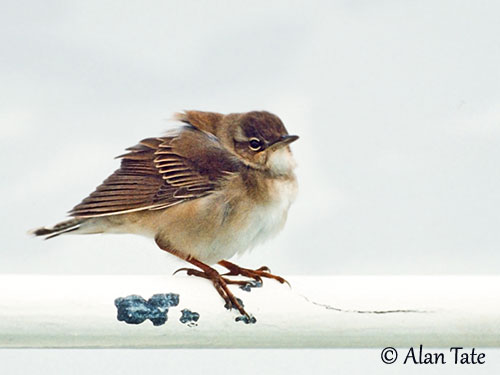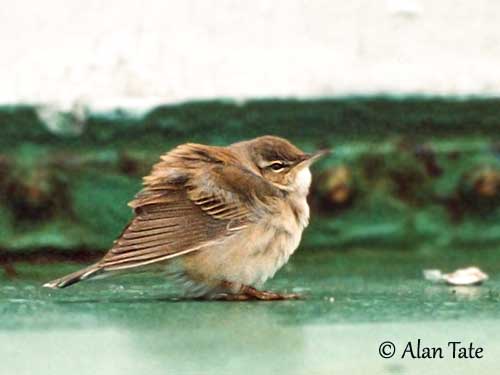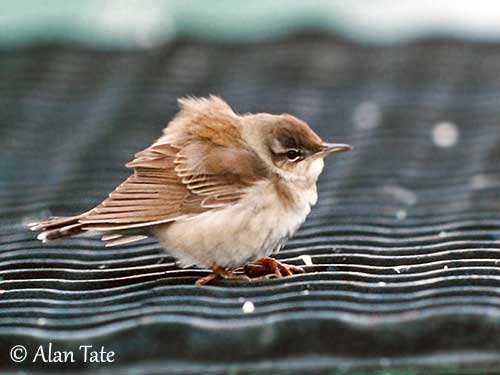
Fr: Locustelle de Middendorff
Ang: Middendorff's Grasshopper-Warbler
All: Middendorffschwirl
Esp: Buscarla de Middendorff
Ita: Locustella di Middendorff
Nd: Japanse Sprinkhaanzanger
Sd: ochotsksångare
Photographers:
Alan & Ann Tate
AA Bird Photography
Text by Nicole Bouglouan
Sources:
HANDBOOK OF THE BIRDS OF THE WORLD Vol 11 by Josep del Hoyo, Andrew Elliott and David Christie - Lynx Edicions - ISBN: 849655306X
Reed and Bush Warblers Par Peter Kennerley, David Pearson – Helm Identification Guides - Editeur: A&C Black, 2010 – ISBN: 1408134012, 9781408134016
Warblers of Europe, Asia and North Africa De Kevin Baker – Editeur : A&C Black, 2010 – ISBN : 1408131706, 9781408131701 – 360 pages
SORA - Female choice in Middendorff's Grasshopper-Warbler (Locustella ochotensis)
An example of facultative polygyny in Middendorff's Grasshopper Warbler (Locustella ochotensis)
Middendorff's Grasshopper-Warbler
What Bird-The ultimate Bird Guide (Mitchell Waite)
Wikipedia, the free encyclopaedia
Middendorff’s Grasshopper-Warbler
Helopsaltes ochotensis
Passeriformes Order – Locustellidae Family
INTRODUCTION:
The Middendorff's Grasshopper-Warbler is an Old World species found in eastern Asia where it breeds, from E Siberia to N Japan and some islands of W Aleutian Islands and Bering Sea. It migrates southwards to spend the winter in Philippines and Borneo.
It frequents densely vegetated areas near water and swamps. It feeds on various insects and forages under low cover.
During the breeding season, the male sings from exposed perches and during the aerial displays.
The Middendorff's Grasshopper-Warbler is fairly common to locally abundant, and the species is not globally threatened.
The name of this species pays tribute to Alexander Theodor von Middendorff (1815-1894), a German-Russian naturalist who often traveled in Siberia.
DESCRIPTION OF THE BIRD:
Biometrics:
Length: 13-15 cm
Wingspan: 24-25 cm
Weight: 16-24 g
The Middendorff's Grasshopper-Warbler has olive-grey to olive-brown upperparts with faint dark streaks on mantle. Rump and uppertail-coverts are tawny-brown. The brown wings are more rufous than the wing-coverts and the flight-feathers are edged pale buff, especially the outermost long primary with whitish outer web. On the graduated tail, rectrices are tipped white.
The underparts are whitish with pale buff wash on breast sides and flanks, although some individuals may have these areas as darker as mantle. Chin and throat are creamy-white and the breast is sandy-brown with paler centre. The undertail is white with brownish wash.

On the head, crown and nape are olive-brown with greyish cast. The supercilium is creamy-white and extends to rear of ear-coverts. Lores and eyestripe are greyish-brown, sometimes dark brown. The ear-coverts are slightly browner than the crown.
The two-tone bill is greyish-horn on the upper mandible, and mostly greyish-pink but becoming darker towards the tip on the lower mandible. The eyes are dark brown. Legs and feet are dull reddish-brown to greyish-pink.
Male and female are similar. Both have rather short, rounded wings and graduated tail.
The juvenile resembles adults but supercilium, face and underparts are tinged yellow. Upperparts, breast sides and flanks are warmer coloured than in adult. Throat and upperbreast are streaked dark brown.
RANGE:
The Middendorff's Grasshopper-Warbler breeds in E Russia, Kamchatka, Sakhalin, Kuril Islands and N Japan (N and E Hokkaido).
It spends the rest of the year in Philippines and N Borneo.
HABITAT:
The Middendorff's Grasshopper-Warbler frequents open thickets in damp grasslands, reedbeds, low willow (Salix) scrub and bushes and thick vegetation around marshes and near lakes. It also breeds in tall grass or dwarf bamboos on islands and coastal headlands, and in humid clearings and wet areas in subalpine meadows.
Outside of breeding season, it can be found in reedbeds, adjacent scrub and coastal mangroves, wet ditches and freshwater marshes where it can find low emergent vegetation.
CALLS AND SONGS: SOUNDS BY XENO-CANTO
The call of the Middendorff's Grasshopper-Warbler is a quiet “chit”.
The song, given from exposed perches or in flight consists of grating short warbles, a shrill, grinding “drrrt-chrit-chit-cherwee-cherwee-cherwee”.
BEHAVIOUR IN THE WILD:
The Middendorff's Grasshopper-Warbler feeds primarily on insects, and occasionally spiders, small molluscs and berries.
It forages among the dense vegetation, in grass and bushes. It usually stays on the ground or under the dense cover. It can be observed skulking around, keeping low down in the vegetation.

During the breeding season, the territorial male sings from exposed perches, but it also sings during the aerial displays consisting of short, looping, brief hovering song flights. It sings at night and much of the day.
The female chooses a male with a good territory providing abundant food, rather than a very beautiful male. They are monogamous.
The Middendorff's Grasshopper-Warbler is migratory. It leaves the northern breeding grounds in late August/early September, in late September in S Sakhalin, and through October in S Kuril Islands.
It migrates southwards, following a direct route to Philippines where most of them are observed in late September and October. Others continue to Borneo.
The return migration is late but rapid, as they remain on their wintering grounds until early May. They arrive from mid-May and late May, and only in early June/mid-June in Kamchatka.
The Middendorff's Grasshopper-Warbler is often reluctant to fly if disturbed. It flies at low level before to dive into the thick cover. It performs short-weak flights with rapid wingbeats alternated with wings tucked to body sides, giving slightly undulating flight.
REPRODUCTION OF THIS SPECIES:
The laying takes place between mid-June and early July.
The Middendorff's Grasshopper-Warbler builds the nest on or near the ground, well hidden among grass or reeds. The cup-shaped structure is made with dead leaves, grass stems and dried grass. The cup is lined with plant fibres and soft materials such as small feathers.
The female lays 5-6 pink eggs with black markings. She incubates during 13-15 days.
No more information.
PROTECTION / THREATS / STATUTS:
The Middendorff's Grasshopper-Warbler is described as “common and locally abundant” within the range.
The size of the population is unknown, but it is suspected to be declining due to habitat destruction.
However, the Middendorff's Grasshopper-Warbler is not considered globally threatened, and the species is currently evaluated as Least Concern.
